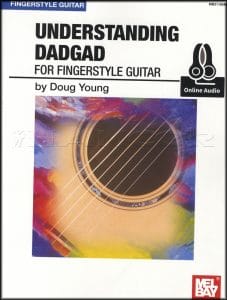DADGAD is becoming such a popular alternate tuning for acoustic guitarists that’s it’s called “the other standard tuning.”
Mel Bay Presents Understanding DADGAD for Fingerstyle Guitar offers a clearly-explained introduction to playing fingerstyle DADGAD guitar.
See the post, Guitar Players Who Have Tuned in DADGAD.
 The book starts out with the basics: how to get your guitar into DADGAD tuning, and an introduction to three chords that only require one fretting finger. However, this is not a book for beginners. Before starting this book, you should…
The book starts out with the basics: how to get your guitar into DADGAD tuning, and an introduction to three chords that only require one fretting finger. However, this is not a book for beginners. Before starting this book, you should…
- Be able to play simple fingerstyle pieces that have independent bass lines, melodies and moving voices. This includes playing with the thumb and two or three fingers of the picking hand.
- Be able to read tablature and understand guitar chord diagrams. You are not required to read standard notation, although all of the examples are also presented in standard notation.
- Be familiar with standard tuning and know the common chords.
- Know how to play fundamental guitar techniques including hammer-ons, pull-offs, and slides.
How DADGAD Tuning Relates to Standard Tuning
The thing I like about this book is that it doesn’t just teach the chords and notes to play DADGAD guitar, it clearly describes how DADGAD relates to standard tuning. In the Leveraging Standard Tuning chapter, lessons include:
-
- Using Standard Tuning Chord Shapes in DADGAD
- Converting Scales from Standard Tuning to DADGAD
- Creating Blues Scales in DADGAD
- The Standard Tuning CAGED System.
- CAGED Applied to DADGAD
Another thing that I like about this teaching method is that the author teaches lessons based on intervals and harmony. The book is sprinkled with lots of lessons on theory, and how it relates to the guitar in general and to DADGAD tuning specifically.
For example, one theory lesson addresses using Roman numeral chord names. He starts with the basic I, IV, V progression. (If you don’t understand the concept of I, IV, V now, you will after going through this book.) He then applies this theory to the simplest case, the I, IV, V progression in D, which uses the D chord, G chord, and A7 chord, all of which can be played with one finger on the fretting hand.
Lessons also teach which intervals are used to build various chords. This is fundamental, once a student knows the “recipe” that makes up a chord, she will have a good foundation in understanding how chords and scales are built.
The book progresses from simple to more complex and covers areas such as:
-
-
- Tricks and Techniques
- Chord Progressions
- Scales and Arpeggios
- Exploring Different Keys
-
The book lays a complete foundation for playing DADGAD fingerstyle guitar. Most of the examples are presented as exercises, rather than tunes. To add to the fun of working through this book, you may want to pick up a book of graduated DADGAD tunes to practice some of the concepts you’ll be learning as you progress through this book.
Mel Bay Presents Understanding DADGAD for Fingerstyle Guitar is well worth the price. I would recommend it for any intermediate guitarist with basic fingerstyle skills who is looking to expand her repertoire and explore alternate tunings.
Buy Understanding DADGAD for Fingerstyle Guitar at Amazon.